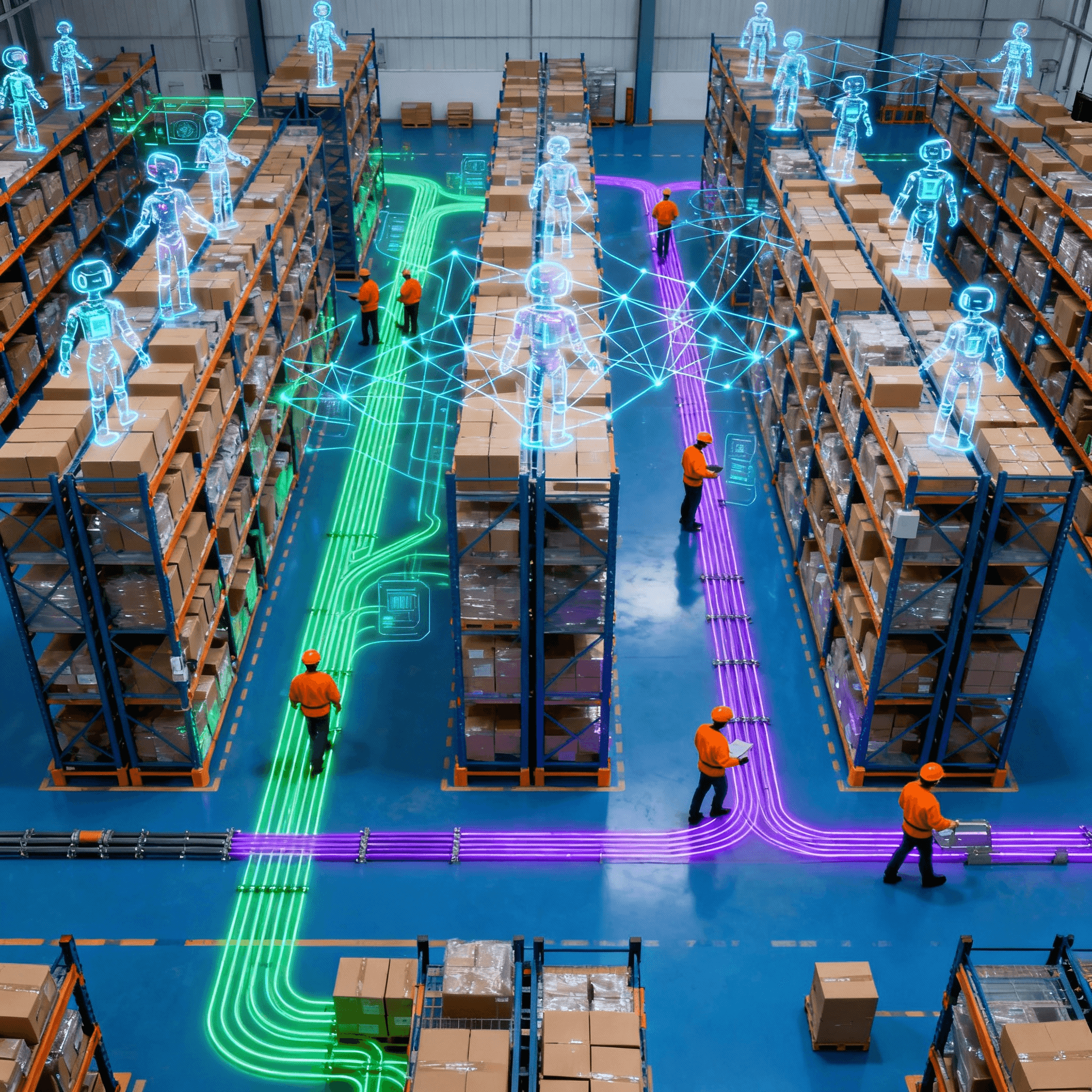Monday, 27 Oct 2025
|Zero-Waste Warehouse: AI Agents for Space, Energy, Labor Optimization

Introduction: Revolutionizing Warehouse Efficiency for a Sustainable Future
Legacy warehouse systems often result in 25-35% wasted resources due to disjointed optimizations that fail to balance space, energy, labor, and throughput simultaneously, leading to inflated costs and reduced scalability in high-demand logistics environments. AI agents enable zero-waste warehouse operations by leveraging multi-dimensional intelligence to optimize these factors in real-time, achieving up to 40% efficiency gains and transforming facilities into agile, eco-friendly hubs that drive profitability. These autonomous systems integrate IoT data, machine learning models, and predictive analytics to dynamically adjust operations, ensuring every square foot, watt, hour, and process contributes maximally without excess.
For logistics executives—CEOs, CXOs, and COOs—this approach addresses the escalating pressures of e-commerce growth, labor shortages, and sustainability mandates, positioning organizations to cut operational expenses by 20-30% while enhancing throughput during peak seasons. This detailed exploration uncovers the core mechanisms of AI-driven optimization, backed by ROI models, implementation strategies, and case studies from leading adopters, offering a blueprint for achieving true zero-waste excellence. As supply chain disruptions become routine, mastering this intelligent orchestration is critical for building resilient, future-proof warehouses.
Exposing the Hidden Waste in Traditional Warehouses
Conventional warehouses suffer from siloed management, where space optimization ignores energy use, labor scheduling overlooks throughput demands, and overall efficiency plateaus at 65-75% utilization. Space waste manifests in static layouts that underutilize 20% of floor area through poor slotting and dead stock accumulation, inflating real estate costs amid rising rents. Energy inefficiencies, such as constant full-load HVAC and lighting, consume 30-40% more power than necessary, contributing to high utility bills and carbon footprints that conflict with ESG goals.
Labor remains the largest inefficiency, with manual processes causing 15-25% idle time and error rates up to 4%, leading to rework and delayed shipments that erode customer satisfaction. Throughput bottlenecks, like congested picking zones or uncoordinated inbound/outbound flows, cap daily output at 80% capacity, forcing costly expansions or overtime during surges. These interconnected wastes compound, resulting in annual losses of $500,000+ for a 200,000 sq ft facility, underscoring the need for AI agents to deliver holistic, proactive solutions.
The AI Agent Framework: Holistic Optimization in Action
AI agents create a unified ecosystem that processes multi-source data— from sensors and WMS to external forecasts—using advanced algorithms like genetic optimization and reinforcement learning to balance all dimensions seamlessly. A master agent oversees specialized sub-agents for space, energy, labor, and throughput, running continuous simulations to predict and prevent imbalances, such as reallocating idle space to buffer high-velocity SKUs while conserving energy. This autonomy reduces human oversight by 70%, allowing executives to focus on strategic growth rather than firefighting daily inefficiencies.
Edge computing enables low-latency decisions, with agents adapting to real-time events like order spikes or equipment faults, ensuring operations remain fluid and waste-minimal. Integration with existing systems via APIs provides transparent dashboards for monitoring KPIs, fostering data-driven refinements and compliance with standards like ISO 14001 for sustainability. The outcome is a self-correcting warehouse that evolves with business needs, delivering consistent zero-waste performance.
Space Mastery: Adaptive Slotting and Flow Dynamics
AI agents dynamically reconfigure space by analyzing SKU patterns, demand forecasts, and return rates to achieve 95% utilization, eliminating dead zones through automated slotting that relocates items based on velocity and co-picking correlations. For example, agents can shift seasonal goods to accessible bays pre-peak, reducing picker travel by 28% and freeing 18% more area for expansion without capital outlay. Vertical space optimization uses computer vision to stack pallets efficiently, minimizing aisle waste and enhancing safety.
Cross-warehouse coordination allows agents to preemptively transfer inventory, preventing overstock in one site while optimizing flow in another, cutting storage costs by 22%. This dimension integrates with others, ensuring space gains support labor efficiency and throughput without energy spikes.
Energy Intelligence: Adaptive and Predictive Controls
Agents monitor occupancy and environmental data to modulate energy use, dimming lights in inactive zones and adjusting HVAC via predictive models that anticipate activity peaks, yielding 30-45% savings. Integration with smart grids schedules high-energy tasks during off-peak rates, while IoT sensors detect leaks or inefficiencies for immediate remediation. Sustainability features track emissions, optimizing for renewable integration and generating reports for green certifications that attract premium clients.
By linking energy to throughput, agents throttle equipment speeds during low-demand periods, maintaining output while slashing consumption by 25% overall.
Labor Precision: Smart Allocation and Ergonomics
Real-time tracking and skill profiling enable agents to assign tasks optimally, matching workers to jobs by proximity, expertise, and stamina to cut idle time by 30% and boost output per shift. AR-assisted picking reduces errors by 40%, with agents forecasting staffing needs to avoid overtime and integrate temps seamlessly. Ergonomic analysis prevents injuries by rotating heavy lifts, lowering absenteeism and insurance costs.
Collaboration with throughput agents ensures labor scales dynamically, achieving 20% productivity lifts without headcount increases.
Throughput Acceleration: Bottleneck-Free Orchestration
Agents simulate end-to-end flows to preempt chokepoints, sequencing waves and routing AGVs/humans for 35% faster fulfillment. Predictive rerouting handles disruptions like inbound delays, maintaining 98% on-time rates. Holistic ties ensure throughput surges don't waste space or energy, enabling 50% volume handling without proportional resource hikes.
Roadmap to Zero-Waste Implementation
Begin with an audit to quantify baseline waste across dimensions, then pilot space and labor agents in a single zone for 3-month proofs yielding 15% gains. Scale to full orchestration in months 4-6, integrating energy and throughput for 25% ROI. By year-end, refine with ML feedback for sustained 40% efficiencies, budgeting 7% of ops for 5x returns. Address integration challenges via vendor partnerships for smooth adoption.
ROI Insights and Real-World Impact
Benchmarks indicate 300-500% ROI, with space/energy savings alone covering costs in 8 months. A U.S. 3PL saw 32% cost cuts post-implementation, handling 45% more orders sustainably. FedEx's AI warehouses report 28% throughput boosts, proving scalability.
Explore More on Debales.ai
- Zero-Waste Warehouse AI: Dead Stock & Layout Optimization
- Self-Optimizing Warehouse: Agentic AI Operations
- Agentic AI Warehouse Automation
- AI Agents Warehouse Safety & Compliance Monitoring
- Smarter Warehouse: AI Agents No Robots
Unlock Zero-Waste Potential Now
Transform your warehouse into a zero-waste powerhouse. Contact Debales.ai for a customized optimization assessment.
Conclusion: Building the Zero-Waste Warehouse Imperative
AI agents' multi-dimensional optimization eradicates waste, balancing space, energy, labor, and throughput for superior efficiency and sustainability. Logistics leaders adopting this framework gain cost advantages and agility essential for 2025's challenges. The zero-waste warehouse is achievable—seize it to lead in intelligent operations.
All blog posts
View All →
Friday, 31 Oct 2025
AI Skills Gap: Make-or-Buy Analysis for Logistics Talent and Partnerships
Address the AI skills gap in logistics: Make-or-buy strategies for internal training, talent acquisition, and tech partnerships to build capabilities efficiently.

Friday, 31 Oct 2025
AI Agents: From Firefighting to Strategic Leadership in Logistics
Discover how AI agents automate routines to elevate organizations: Shift from reactive firefighting to high-value strategic initiatives in logistics.

Friday, 31 Oct 2025
AI Logistics Talent Strategy: Essential Skills for Data Literacy, AI Management
Develop critical talent for AI-driven logistics: Strategies for data literacy, AI system management, strategic decision-making to optimize organizations.